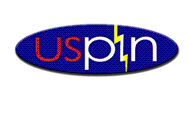
Current lightning figure courtesy of the USPLN/NAPLN and WSI Corp.
Click image for full size.
General InformationRegistration is required to request access to the USPLN/NAPLN data feed. This free data feed is made available to the educational and research communities on an annually renewed basis. Please read the ERAU-WSI--USPLN Data Access Policy associated with getting this proprietary data set. There are a number of restrictions that you must agree to before you accept this data feed.By registering you will be able to receive the data from a primary or backup server using the LDM software that is freely available from Unidata (http://www.unidata.ucar.edu/software/ldm/). The decoders that are provided by Unidata for GEMPAK and McIDAS software packages have been updated by Unidata to support this data feed. Details for configuring your LDM configuration are provided here and will be sent after registration is complete and the LDM servers have been configured to allow your system. If you are not a full-time faculty or staff member at your institution, you may not register for this data feed. Please ask a faculty or staff member from your institution to complete this registration form to obtain access to this feed. Please see the data access policy for more information. If you haven't requsted the data yet, please go here to register LDM Configuration ItemsHere are some items that may be of help for your configuration. There are two different data sets available; one is the USPLN, while the other is known as the NAPLN. The geographic areas of coverage for the two data sets is what distinguishes them from each other.In addition to having two different data sets, there are two different formats available. For convenience we have labeled these "original" and "extended" in the table below.
The table above is from the Unidata web site at their lightning data information page (http://www.unidata.ucar.edu/data/lightning.html#uspln).
Request Syntax:The older releases of the decoders require that you subscribe to the older format of the USPLN and NAPLN feeds. (This is the "original" format from the left side of the table above.) The newest releases of the GEMPAK and McIDAS decoders support both data formats.Note: The feedtype "LIGHTNING" is equivalent to "NLDN" (or FT14) beginning with LDM-6.7.x+
For: GEMPAK/McIDAS decoders prior to GEMPAK v5.11.4 / LDM- McIDAS prior to v2009ldmd.conf EntryREQUEST LIGHTNING USPLN1-ltg* feedsite.domain feedsite.domain will be providedpqact Entry LIGHTNING USPLN1 PIPE decoders/dcuspln -m 25000 -b 5 -s minute05 -d data/gempak/logs/dcuspln.log -e GEMTBL=/home/gempak/GEMPAK5.11.1/gempak/tables data/gempak/uspln/YYYYMMDDHHNN_uspln.gem For: GEMPAK/McIDAS decoders beginning with GEMPAK v5.11.4 / LDM-McIDAS v2009 and newerREQUEST LIGHTNING USPLN1EX-ltg* feedsite.domain feedsite.domain will be providedpqact Entry LIGHTNING USPLN1EX PIPE decoders/dcuspln -m 25000 -b 5 -s minute05 -d data/gempak/logs/dcuspln.log -e GEMTBL=/home/gempak/GEMPAK5.11.1/gempak/tables data/gempak/uspln/YYYYMMDDHHNN_uspln.gem For the above examples you would replace USPLN with NAPLN for the second data set. A second decoder line would also be required for the NAPLN.
Additional Pqact Entry Syntax:We have discovered that the Linux EXT3 filesystem has a limitation for the directory entries where it makes sense to save the raw data by day for a directory level organization.
Product Display:Example scripts and tips are coming.... |



